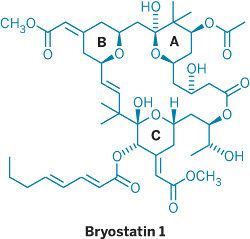 | ||
Bryostatin marine chemistry spring 2016
Bryostatins are a group of macrolide lactones first isolated in the 1960s by George Pettit from extracts of a species of bryozoan, Bugula neritina based on research from samples originally provided by Jack Rudloe to Jonathan L. Hartwell’s anticancer drug discovery group at the National Cancer Institute (NCI). The structure of bryostatin 1 was determined in 1982. To date 20 different bryostatins have been isolated; further, certain analogs of bryostatin have been referred to as "bryologs". Bryostatins are potent modulators of protein kinase C. They are currently under investigation as anti-cancer agents, as anti-AIDS/HIV agents and as a memory-enhancing agent.
Contents
- Bryostatin marine chemistry spring 2016
- Biological effects of bryostatin 1
- Anti cancer
- Neurological
- Total synthesis
- References
Biological effects of bryostatin 1

Bryostatin 1 is a potent modulator of protein kinase C (PKC). Short-term effects of bryostatin 1 include activation of classical or conventional PKCs and novel PKCs, whereas prolonged presence leads to lowered PKC activation. Bryostatin 1 effects on different isoforms of PKC vary. In in vitro tests bryostatin 1 was able to inhibit cell growth and angiogenesis and to excite cell differentiation and apoptosis. Bryostatin also shows immunomodulatory properties.
Anti-cancer

In in vitro trials bryostatin 1 was able to induce apoptosis in HL-60 chronic lymphocytic leukaemia. It could be shown that bryostatin 1 acts synergistically in combination with other anti-cancer drugs. Drug combination was effective against a large variety of tumor cells including lung, prostate and non-Hodgkin's lymphoma tumor cells. Although animal studies were promising, bryostatin 1 as a single drug has failed to demonstrate significant activity in tumor patients in phase II trials in a wide range of tumor types, including melanoma and colorectal cancer. Additionally severe side-effects, mainly myalgia, were observed after bryostatin administration. As a consequence research focus has shifted to an investigation of combination therapy with other chemotherapeutic antitumor agents such as gemcitabine, vincristine, cisplatin, and paclitaxel. As of 2016 about 30 clinical trials for various cancers have been completed.
Neurological

Bryostatin 1 has appeared very promising in enhancing memory in animal models. It was able to increase the duration of memory retention of the marine slug Hermissenda crassicornis by over 500%. Additionally it also increased the rate of learning in rats. This makes it a possible drug candidate for the treatment of Alzheimer's disease. As of 2014, bryostatin 1 is in clinical trial phase II for the treatment against Alzheimer's disease.

The ability of bryostatin 1 to alleviate brain damage in ischaemically brain-injured rats also seems promising and may open another therapeutic field for bryostatins.

A phase II clinical trial (running from 2015 to 2017) is comparing two IV doses over 12 weeks against placebo for Moderately Severe to Severe Alzheimer's Disease.
Total synthesis
The low concentration in bryozoans (to extract one gram of bryostatin, roughly one tonne of the raw bryozoans is needed) makes extraction unviable for large scale production. Due to the structural complexity, total synthesis has proved difficult, with only a few total syntheses reported so far. Total syntheses have been published for bryostatins 1, 2, 3, 7, 9 and 16. Among them, Krische’s total synthesis of bryostatin 7 via C-C bond forming hydrogenation is the shortest synthesis of any bryostatin reported, to date.
A number of structurally simpler synthetic analogs also have been prepared which exhibit similar biological profile and in some cases greater potency, which may provide a practical supply for clinical use.
Investigations on how bryostatin 1 behaves in a unique fashion are ongoing in several laboratories.
